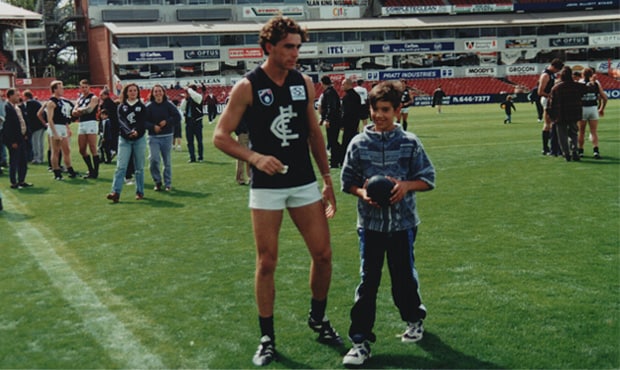He was recruited to Carlton as a rookie, he’s a John Nicholls Medallist, he’s vice-captain of the club and he wears the No.44 as a badge.
Think you know all there is to know about Andrew Carrazzo?
Think again. For the man in the No.44 should technically answer to Carrazza with an “a” rather than Carrazzo with an “o”.
Carrazzo has revealed as much in an interview to promote his Italian lineage and the Carlton connection through a three-minute feature film commissioned by the club for the 2014 Virgin Australian Film Festival.
This extraordinary tale has its origins in the days leading up to The Great War, when Andrew’s paternal great great grandfather Leonardo Carrazza bid farewell to family in his southern Italian hometown of Montemurro and disembarked a steamship in the port of Melbourne.
The story goes that Leonardo, a part-time organ grinder, briefly went back to Italy, then returned with his teenage son Adolfo. It seems that on arrival in Melbourne, the family disembarkation papers were mistakenly recorded as “Carrazzo” rather than “Carrazza”, and the name stuck.
Then, when the call came for young men to fight for King and Country, further complications arose. Adolfo tried to enlist despite being underage – only to be thwarted by his father - so he re-enlisted under a nom-de-plume.

The Carrazzo family pictured on the day they arrived in Melbourne. (Photo: Carrazzo family)
“He (Adolfo) re-enlisted under the name of ‘Charlie Brown’ rather than Carrazzo,” Andrew said.
“Through a long connection we’ve found all these Browns in Melbourne who should be ‘Carrazza’, as well as Carrazzos who should be Carazzas. We also have a lot of relatives in Mildura named ‘Carrazza’.”
Though he says he would never revert to the original surname, Carrazzo - at 30 and now some 176 games and 11 seasons into his senior career - is reflecting more than ever on football and family.
Which is why the opportunity to feature in this film is so timely.
“A big part of this film is telling people a little bit about my story and my family’s history with Carlton. But another part of it for me was telling the story of our supporters, the connection they have to the area, and the huge role that they play,” Carrazzo said.

A young Andrew Carrazzo meets Ang Christou at the Carlton Family Day in 1996. (Photo: Carrazzo family)
“Our supporters are synonymous with the working class area of Carlton and what it meant back in the 1950s and ’60s.”
Lamenting the death of zoning in reflecting on the days when football was truly territorial, Carrazzo, the last man to complete his senior debut on the old Carlton ground, understands there’s no point keeping your eyes fixed to the rear vision mirror.
“We’re in the 21st century now with state-of-the-art stadiums, where it’s more cost-effective for more teams to be playing out of the one stadium,” Carrazzo observed.
“A best case scenario would be that Carlton still plays here, Collingwood still plays at Victoria Park, Richmond played at Punt Road, the Bulldogs played at the Whitten Oval and Essendon still played at Windy Hill, so that home-town feel remains. It’s a bit of a shame, but that’s the way of the world.”



